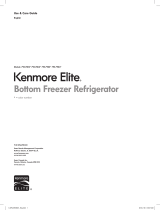
18
NOTE: It is necessary to have a water source when both
water and/or ice dispensers are available in your product.
BEFORE START
The water source is not guaranteed by the refrigerator
manufacturer. Follow instructions carefully in order to
reduce damage.
Air located inside the water pipes can cause hammering
or tapping causing damage to the inner pipes or water
spillage in the inside of the refrigerator. Call a qualified
plumber to fix such hammering on the connections
before installing the water pipe.
To avoid burn damage or such, never connect refrigerator
to hot water pipes.
If you are to use the refrigerator before connecting it
to the water source, make sure the ice maker is the off
position.
Never attempt to install the ice maker pipes in areas
where room temperature is below freezing point.
When using any electrical device (like a drill) during
the installation, make sure device is doubly isolated or
making ground to prevent risk of electrical surge or
discharge.
All installations should be done considering local water
and drainage requirements.
If an inverted osmosis water filtration system is
connected to the cold water source, the water hose
installation is not assured or guaranteed by the
refrigerator or automated ice maker manufacturer.
Follow the next instructions carefully to minimize costly
water related damages.
When having an inverted osmosis water filtration
system connected to the cold-water flow, the water
pressure for such system must be at least between
40-60 PSI or 0,27 MPa (2,8 kg · f / cm ² ~ 4,2 kg · f
/ cm ², (2,8 kg · f / cm ² ~ 4,2 kg · f / cm ², less than
2 ~ 3 seconds to fill a 7 oz of capacity cup [0,2 liters]).
If the inverted osmosis water filtration system pressure
is less than 21 PSI or 0,14 MPa (1,5 kg · f / cm ², more
than four (4) seconds to fill a 7 oz of capacity cup [0,2
liters]):
a) Identify if the sediments filter in the inverted osmosis
system is being blocked. Replace filter if necessary.
b) Allow inverted osmosis system storage tank to refill
after extensive usage.
c) Call a qualified plumber if the inverted osmosis water
pressure problem continues.
REQUIREMENTS
1/4” (6,35 mm) in diameter copper pipe
to connect refrigerator to the water
pipe. Make sure both terminals are
cut in a squared manner.
To determine how much pipe material is needed,
measures the distances between the valves located
behind the refrigerator and the source of water and add
to that 8 feet (2,4 m). Make sure there is sufficient pipe
material to allow the free movement of the refrigerator
from the wall
A cold water source. Water pressure should be between
0,138 and 0,82 MPa or 20 and 120 PSI for models not
containing water filter and between 0,276 and 0,82
MPa or 40 and 120 PSI for models containing water
filter.
A drill.
Adjustable 1/2”(12,7 mm) key.
Flat and Phillips style (star) screwdriver.
Two 1/4” (6,35 mm) diameter
compression nuts with two
sides to connect the copper
pipe to the refrigerator valve.
If your current copper pipe has some
reduction on the ends, it will be
necessary to get and adaptor (found
in hardware stores) to connect the
water line to the refrigerator. It is also
possible to cut such reductions with a pipe cutter and
use the compression connections mentioned above.
Bypass valve to connect to
the cold water line. The valve
must have a water opening
with an interior 5/32” (3,46
mm) diameter in the cold-
water connection point.
These valves can be located
in any cold-water connection package. Before buying
make sure such valve meets local standards and
requirements.
INSTALLATION INSTRUCTIONS
Install the valve to the pipe that you use to drink water.
CAUTION: Connect to potable water supply only.
1. CLOSE THE MAIN WATER SOURCE
Open the nearest water faucet to let water flow and
empty pipes.
2. SELECT THE LOCATION OF THE
VALVE
Select the location of the valve that
will provide a better access. It is best
to connect to a vertical pipeline. When
connecting to a horizontal pipeline is
necessary, make the connection in the
lateral or upper area instead of the
lower area to prevent accumulation of
sediment.
CONNECTING THE WATER LINECONNECTING THE WATER LINE





















